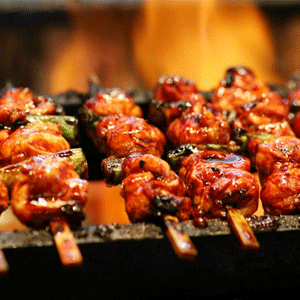Oct 07, 2011
Yakitori – Grilled Chicken on a Stick. It’s good!
 Yakitori in a nutshell: kill chicken, put on stick, grill over fire, and eat. The world at large suffers a serious lack of meat on a stick options, but Japan is a glorious exception to this rule. Here, you can get basically anything on a stick. Once while viewing the fall colors at Korankei, near Toyota City, I ate grilled sparrow. How could I say no to that? It was tasty. As expected.
Yakitori in a nutshell: kill chicken, put on stick, grill over fire, and eat. The world at large suffers a serious lack of meat on a stick options, but Japan is a glorious exception to this rule. Here, you can get basically anything on a stick. Once while viewing the fall colors at Korankei, near Toyota City, I ate grilled sparrow. How could I say no to that? It was tasty. As expected.
Yakitori, literally translates as grilled chicken, and belongs to the family of Japanese foods called kushiyaki (串焼き), which simply means skewer grilled. It sounds simple, but a great chef with quality ingredients and seasonings can make it taste like a whole lot more.
More specifically, yakitori consists of between 3 and 10 small pieces of chicken (beef, pork, etc) meat or innards (properly, ofal) skewered on a bamboo stick, seasoned, and grilled; generally over charcoal. You will find most dishes offered in either salt or tare flavor. They will probably ask which you prefer when you order. Salt, or shio (塩-しお-シオ), is simply salted at grilling, but tare (たれ-タレ) is a sauce usually made with mirin, sake, soy sauce, and sugar- although really, how many Japanese foods are NOT made with those ingredients? Variety people; look into it! The tare is brushed on before and during grilling. Some places have set menus and do not offer a choice of flavors, but most do.
Yakitori (焼き鳥 -やきとり -ヤキトリ) can be written in pretty much any of the Japanese scripts, though in kanji seems to be the most common. Keep an eye out for a lantern thing with some of the script above on it and you will be golden for your meat on a stick fix. Here are some common varieties of yakitori that are readily available. 
• toriniku, white meat, usually breast meat
• tebasaki (手羽先), are chicken wings (remember that dance?)
• tsukune (つくね), are chicken meatballs (I am keen on these)
• (tori)kawa ((とり)かわ)is chicken skin, grilled crispy ( love this with salt)
• negima (ねぎま) are pieces of chicken alternating with pieces of green onion (ネギ)
• bonjiri (ぼんじり), are chicken tails (love these too)
• nankotsu (なんこつ), are chicken cartilage (interesting, this one)
• rebā (レバー), is liver (these are best just a bit raw in the middle!)
• hatsu (ハツ) or kokoro (こころ), are chicken hearts
• sunagimo (砂肝), or zuri (ずり) are chicken gizzards
• shiro (シロ), are a chicken’s small intestines (don’t think, just eat it!)
For a list of good places in Nagoya to try some yakitori, see the full text of this article at www.japaninfoswap.com. If you have questions about Japan why not ask at @japaninfoswap, or post on the wall at facebook/japaninfoswap
How To Make Chicken Yakitori — Video Recipe: Make delicious yakitori skewers.


About the author